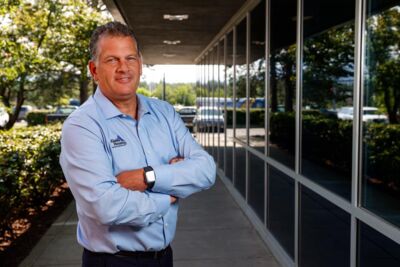Making an Impact Through Energy Efficiency

When Michael worked as a schoolteacher and seasonal construction worker, energy efficiency wasn't something he gave much thought. But in 2009 he pursued an opportunity to leave seasonal work behind and trained as an energy rater, discovering a new career path and a way to make a positive impact for Alaska homeowners.
Michael joined Alaska Housing Finance Corporation’s department of Research and Rural Development as an energy rater in 2011 and today he is the energy program manager, guiding a team that works on education, energy ratings, building codes and building monitoring systems for commercial buildings.
“Basically, we have the energy efficiency of the built environment in Alaska covered,” he said.
Supporting the Mission
Michael explained that the variety of projects he gets to contribute to is one of the things he most enjoys about his role. “No two days are the same in our department,” he said.
“One day we might be dealing with federal programs through the U.S. Department of Energy, the next we are focused on internal projects like issuing AHFC’s building codes. It’s always changing.”
What doesn’t change, despite the variety of tasks, is the department’s contribution to AHFC’s mission: providing Alaskans access to safe, quality, affordable housing.
According to Michael, the department of Research and Rural Development helps to find the balance between the parts of this mission statement.
“By issuing building codes, we help to make sure homes are built properly," he said. "A house might seem affordable now, but if it isn’t high quality and energy efficient then in 10 years that home may not be affordable to heat or to upgrade, and it might not be safe. We help to strike that balance and find the right solution depending on the resources available.”
Energy Efficiency
Educating Alaskans on energy efficiency is another way Michael and his team help homeowners strike a balance between affordability and quality.
“Heating your home is expensive,” Michael said. “But you can reduce the need for heat by effectively insulating and air sealing, for example. The bottom line is, if you don’t have to use it, it doesn’t cost you anything.”
Before training as an energy rater, Michael only worked on houses on a cosmetic level, but even that was laying the groundwork for his current focus on energy efficiency.
“I always wanted the homeowners to know what was going on with their house, even if they were only making cosmetic changes,” he said. “In some ways, that’s a throughline to the work I do now – energy efficiency is all about knowing what is happening in your home.”
Opportunities to Learn
Michael has traveled widely across Alaska performing energy audits, providing building code training and community education. He sees the opportunity for two-way communication as invaluable to his work.
“It could be easy for us to assume we know the right answer when it comes to energy efficiency in remote areas, but we don’t always have the full picture,” he said. “What we suggest might not work, and the only way to discover that is to talk to people directly, listen to and understand their needs and respect their input.”
He said that this emphasis on asking questions and learning from others is the primary message he would hope to communicate to the public about his field of work.
“I wish people weren’t afraid to ask questions. Houses are complex and if you don’t know something, that’s fine,” he said. “Unless you ask, you won’t get an answer. People should know that they can contact us at any time about any question and we will do our best to help them.”
If you connect with our mission to provide Alaskans access to safe, quality, affordable housing, consider a career at AHFC.
For information about energy efficiency or the department of Research and Rural Development, visit ahfc.us/efficiency.
![Alaska Housing Finance Corporation [Logo]](/application/themes/ahf2/images/logo.png?v=2)